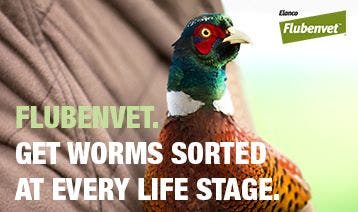Flubenvet Brochure
Take control of your poultry's welfare and productivity with the only dewormer that targets all life stages - not just the adult stage1
Worms that have reached adulthood live inside the bird, reproduce and can cause a variety of symptoms, including:
- Loss of shell colour and strength
- Eggs with pale yolksReduced egg production and size
- Reduced appetite and weight lossPoor feed conversion
- Increased cannibalism via vent peckingIncreased risk of egg peritonitis
Worm burdens can even be fatal.
Why is broad-spectrum deworming with Flubenvet important?2,3
Parasitic worms can damage the health, welfare and performance of your birds. Housed and free-range birds are in contact with their own faeces and are therefore exposed to parasitic worms cycling in the litter.
Flubenvet controls all of the key species of worms affecting your birds:
Roundworms
The biggest and most common, living in the small intestine. Infection can cause a significant drop in egg production. Occasionally, roundworms may undergo an aberrant migration and become incorporated into an egg to be laid by the bird.
Gapeworms
Infect intermediate hosts, such as earthworms and snails, which are then ingested by poultry. They inhabit the lungs and windpipe, causing birds to ’gape’ or ’snick’ as they struggle to breathe.
Caecal worms
Smaller worms inhabiting the lower end of the gut. Infected birds often appear asymptomatic - serious disease of chickens and turkeys causing diarrhoea, egg drop and sudden death.
Hairworms
Found in the stomach and intestines of chickens. Barely visible to the naked eye, but can cause significant commercial damage, as even moderate infestations can be fatal. Birds appearing dull and depressed can indicate hairworm infestation.
Main indications that your flock may have worms are:
- Higher mortality rates
- Marked variations in the size of the flock
- Poor growthPale headsAnaemia
- Reduced laying rates
- Reduced egg weights
- Reduced hatchability
Flubenvet - In feed preventative treatment
Approved for use in layer hens, breeder hens, broilers, geese, turkeys, pheasants and partridges Kills all life stages of all main poultry worm species, including immature life stages and eggs Zero day egg withdrawal for chickens, allowing eggs to be taken for human consumption both during and after treatment
More Materials

Flubenvet™ 5% w/w premix for medicated feeding stuff.
A broad spectrum oral anthelmintic containing Flubendazole.

Flubenvet Brochure
Download the Flubenvet brochure to discover more about how worms affect the health and welfare of your birds
- Flubenvet 5% SPC.
- Permin A & Hansen J. (1998) FAO Animal Health Manual, Epidemiology, Diagnosis and Control of Poultry Parasites. Food and Agriculture Organisation of United Nations. Rome pp. 15-34.
- Pattison M, McMullin F, Bradbury J & Alexander D (2008). Poultry Diseases. 6th edition. Saunders Elsevier. pp. 461-462.
